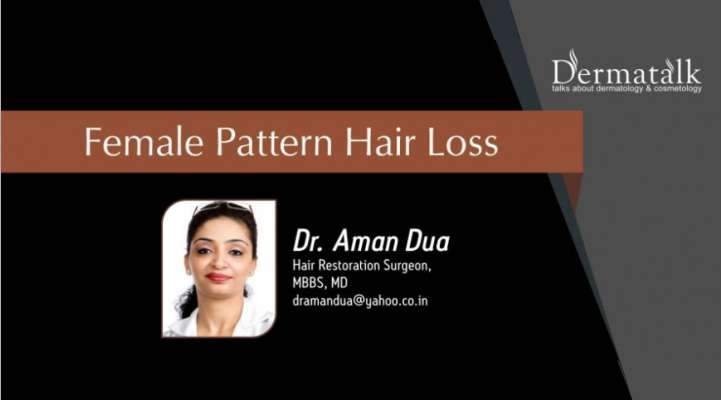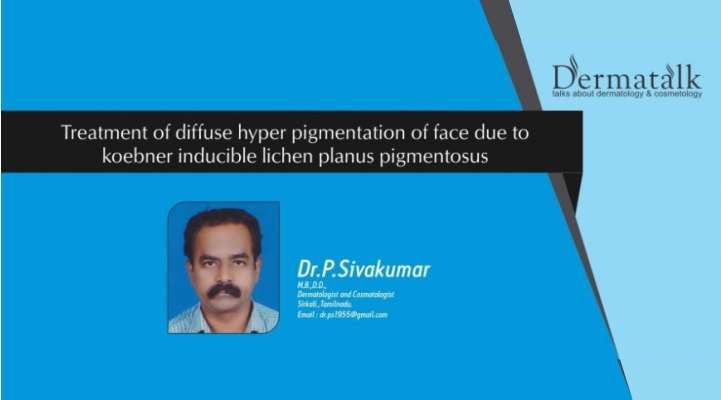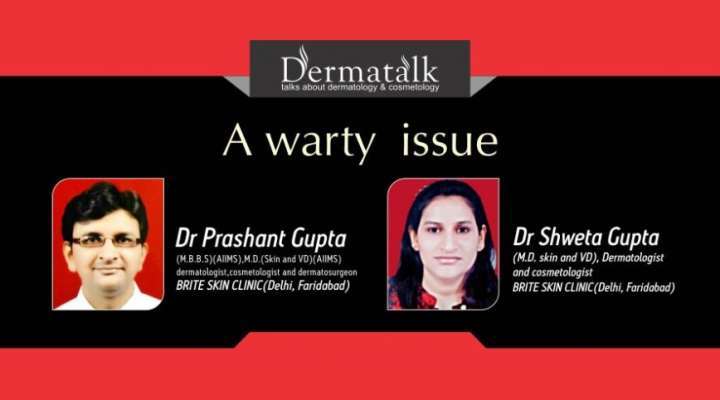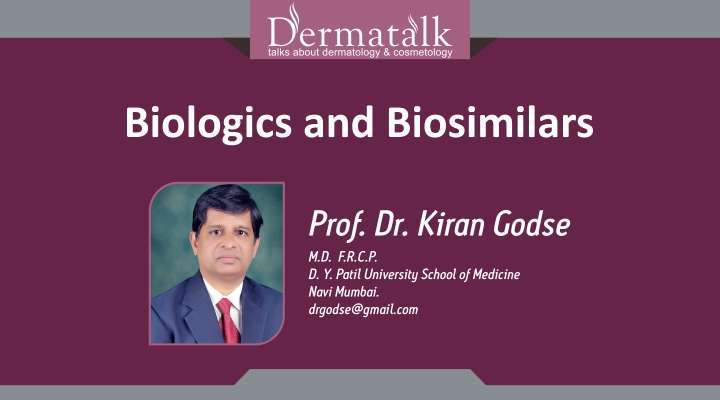Female pattern hair loss (FPHL), or female patterned alopecia, is a form of nonscarring, patterned hair loss occurring commonly in postmenopausal adult women that is characterized by a progressive reduction in hair density on the crown of the scalp with sparing of the frontal hairline (Ludwig scale).
The part width progressively increases, most prominently anteriorly, and demonstrates thinning rather than baldness. Temporal recession occurs to a lesser degree in females than in males. A genetically determined shortening of the anagen phase of growth with a constant telogen phase leads to a gradual conversion of terminal (large, thick, and pigmented) hairs into vellus (short, thin, nonpigmented) hairs.1
Pathogenesis
The hallmark feature of FPHL is the progressive transformation of terminal hair follicles (large, thick, pigmented) to vellus hair follicles (short, thin, nonpigmented), in part due to a genetic predisposition influenced by androgens4,5. Although the process of miniaturization is not fully elucidated, it is known that androgen-responsive hair follicles gradually shorten their anagen (growth phase of the hair follicle) phase, resulting in fewer terminal follicles and more follicles in the shedding phase (telogen). Miniaturization is thought to be induced by the conversion of testosterone to dihydrotestosterone (DHT) by the enzyme 5α- reductase. Androgens exert their effect on hair by means of circulating testosterone derived from the adrenal glands, testes, or ovaries. Only free testosterone has the ability to enter cells and undergo conversion to DHT, which then acts on the androgen receptor in susceptible scalp hair follicles to facilitate the unwanted conversion to a miniaturized follicle6. Interestingly, only a minority of females with patterned hair loss have evidence of hyperandrogenism, such as those with polycystic ovarian syndrome, making the role of increased androgen levels in FPHL unclear 7.Studies suggest that women may have less severe hair loss than men due to lower levels of 5α-reductase and higher levels of aromatase, an enzyme which converts testosterone to estradiol, in susceptible hair follicles8. This pattern of hair loss also can be induced by events independent of androgens9. The role of estrogen in the pathogenesis is also not definitive, although the increasing prevalence of FPHL in postmenopausal women and the hair loss that occurs following aromatase inhibitor therapy suggest that estrogens may stimulate hair growth 10,11. Conversely, genetic studies implicate that an aromatase gene variant resulting in higher levels of estrogen may be associated with the development of FPHL12. Interestingly, the scalps, especially the frontal hair lines, of young women have higher levels of aromatase compared with male scalps, which may explain the decreased severity and relative sparing of the frontal hairline in FPHL. Recently, sequence variation in the gene encoding aromatase, CYP19A1 (cytochrome P450, family 19, subfamily A, polypeptide 1), has been associated with higher circulating levels of estrogens and might influence the risk of developing FPHL 12.
Classification
There are three main patterns described in women.
1. One of the commonly used classification is the centrifugal pattern of hair loss described by Enrick Ludwig. He described 3 grades of severity of hair loss, and the main emphasis in this pattern is the preservation of the frontal fringe.
| LUDWIG’S Grading | |
| Grade I | Thinning of hair seen over the anterior part of the crown with minimal widening of the parting width. |
| Grade II | Thinning of the crown more pronounced with more widening of the parting width, increase in the number of thinner and shorter hairs. |
| Grade III | Crown is more or less bald with significant widening of the parting width. The frontal hairline is still maintained |

1. Olsen has described a Christmas tree pattern with frontal accentuation. She noticed that instead of the diffuse loss over the vault of scalp, they can have increasing hair loss towards the frontal scalp with encroachment on and sometimes breach of the frontal hairline.

2. Male pattern or fronto-parietal pattern described by Hamilton characterized by bi-temporal recession. He reported that about 13% of premenopausal and 37% of postmenopausal women had Hamilton types II-IV male pattern baldness.


Clinical manifestations
FPHL usually presents as a gradual onset slowly progressive loss of hair, in a diffuse pattern over the crown area, with preservation of the frontal hairline. It can also present
with widening of partition, and in few cases similar to the male pattern with bi-temporal or fronto-temporal recession. The main diagnostic feature is the presence of miniaturization, that helps to differentiate from other conditions.
Other associated features of hyperandrogenism should always be ruled out in females and clinical examination can reveal such features like acne, seborrhea, hirsutism, irregularities in menstrual cycles along with hair loss.
Diagnosis
The diagnosis is mainly clinical and biopsy is usually not necessary. Dermoscopy is useful to detect early FPHL and to distinguish FPHL from other hair disorders that can cause hair thinning13. The hair pull test, which is a maneuver performed by the examiner that gently pulls tufts of hairs along the scalp, is usually positive in the affected scalp as miniaturization causes shortening of the hair cycle with increased telogen shedding. When positive in all scalp areas it indicates associated telogen effluvium. Dermoscopic examination of the scalp correlates with the clinical classifications of FPHL, revealing variability in the hair shaft diameter that affects at least 20% of hairs14 and increased number of vellus hairs, parameters which are linked to follicle miniaturization 15. Patients with FPHL may have other skin or general signs of hyperandrogenism such as hirsutism, acne, irregular menses, infertility, galactorrhea and insulin resistance, but most do not. The most common endocrinological abnormality associated with FPHL is polycystic ovarian syndrome (PCOS). Hyperandrogenism is often a common feature between the two conditions and in both, the manifestation of this hyperandrogenism may not correlate with the circulating androgen levels because total circulating testosterone is mostly bound to albumin and sex-hormone binding globulin. But even then, both conditions can be treated with anti-androgens, androgen receptor blockers and enzyme inhibitors to avoid the effects of the androgens in the target organs. Another important association with FPHL is metabolic syndrome because of increased cardiovascular risks. Possible mechanisms to explain the association between these conditions are the presence of 5 alpha-reductase and DHT receptors in the vessels. Patients must also be investigated for systemic and newly diagnosed illnessess within the past year before the signs of alopecia manifested, as well as about significant weight loss, eating habits and medications that can cause hair loss or increase androgen levels 16.
Differential Diagnosis
1. Chronic Telogen effluvium : this is the most often confused diagnosis. However there is often a triggering factor for this condition and it is associated with sudden onset of massive hair fall. The hair loss is generalized and there is no widening of the central partition or bi temporal recession in this case. The hair pull test is positive and there is no miniaturization.
2. Cicatricial alopecia, especially frontal fibrosing alopecia : the presence of a band like hair loss over the frontal area in post menopausal females with features of scarring helps in differentiating this condition from FAGA.
3. Diffuse alopecia areata : this usually occurs in an acute manner with diffuse hair loss. Dermoscopy reveals exclamation mark sign and presence of yellow dots. Biopsy is confirmative
4. Anagen effluvium : occurs due to intake of cytotoxic drugs
5. Trichotillomania
6. Syphilitic alopecia
7. SLE
Treatments
Nutritional supplementation
The benefit of oral supplementation with amino-acids, biotin, zinc, and other micronutrients in hair loss of any origin is controversial. Similarly, an apparent lack of correlation between low serum ferritin levels (<10 g/l) in apparently healthy women with FPHL, CTE, or both raised doubt if iron supplementation will be helpful. 17
Medical treatment
Pharmacological treatments for FPHL may be topical and oral. They can also be divided into drugs with androgen-dependent and independent mechanisms of action.
Topical
Minoxidil topical solution (MNX): MNX is approved for use in FPHL in a 2% formulation as twice daily application of 1 ml solution over dry scalp. Minoxidil increases follicular vascularity (as a potassium channel opener), prolongs anagen, shortens telogen, and converts partially miniaturized (intermediate) to terminal hairs.
Combination of MNX with aminexil (1.5%), a reverser of perifollicular fibrosis, with tretinoin and azelaic acid, and with topical finasteride are also commercially available, but their superiority over MNX alone in FPHL is not established.
Patient should be counseled about the increased hair loss following MNX application followed by stabilization and then noticeable increase in 8-12 weeks that usually peaks after 16 weeks. Minoxidil is a safe treatment; most common adverse effects being unsightly deposits on the hair-simulating dandruff, scalp irritation, and occasionally contact dermatitis that is due to vehicle propylene glycol rather than active molecule. Availability of MNX in gel and foam formulations enhances treatment acceptability. Secondly, as compared with men, women are more likely to develop hypertrichosis on the face (typically cheeks and forehead) and even on other remote sites especially with higher concentrations (5% > 2%). It is reversible on treatment break or reduction of concentration (within 4-6 months) and in some without cessation of treatment. 18 This side-effect may be minimized by wiping face and ears with a wet cloth after MNX application. The MNX being reasonably safe and effective should be considered as the first-line treatment for FPHL.
Oral
Androgen-dependent oral drugs for FPHL include 5α-reductase inhibitors and anti-androgens. Due to their propensity to cause feminization of the male fetus, they are contra-indicated in pregnant women and it is advisable to combine them with oral contraceptive pills (OCPs), especially in pre-menopausal women.
5α-Reductase inhibitors: Although compared with men, women have lower levels of this enzyme in the dermal papilla; inhibitors of this enzyme have been found to be effective in arresting hair loss in FPHL.
Anti-androgens
Anti-androgens act primarily through blockade of the ARs.
Cyproterone acetate: This drug blocks ARs and inhibits gonadotropin- releasing hormone. In many countries such as India, it is available in combination with estradiol as an OCP. The beneficial role of cyproterone acetate (CPA) in isolation or in combination with OCPs in reducing hair shedding and increasing hair density is known and seems to be greater in patients with evidence of hyperandrogenism. In two studies using Diane-35 for 6-9 months and as 2 mg CPA plus 50 μg ethinylestradiol daily plus additional 20 mg CPA on days 5-20 of the menstrual cycle, respectively, decrease in shedding and thinning of hair were observed. While one randomized comparative trial revealed that minoxidil 2% was more effective in women without evidence of hyperandrogenism, whereas CPA was more effective in those with hyperandrogenism, the efficacy of CPA versus spironolactone was found comparable in another trial. 20,21 The overall balance of evidence supports a role for CPA in FPHL, especially in presence of hyperandrogenism.
The most effective treatment dose seems to be 100 mg/day on days 5-15 of the menstrual cycle supplemented by 50 μg ethinylestradiol on days 5-25. 22 The adverse effects include menstrual disturbances, weight gain, loss of libido, depression, breast tenderness, and gastrointestinal upsets.
Surgical treatment
Hair transplantation is advantageous in being less invasive and a permanent hair cover can be re-established. A number of procedures have been tried, of these, follicular unit transplantation (FUT) is in vogue. In FUT, follicular units of 1-4 hairs are transplanted in high densities. Hair transplantation works on the principle of “donor dominance,” which means that the hairs from the donor region (the occiput) inherently lack the androgen-sensitive receptors, a property that is retained even after transplantation into the fronto-parietal region. It is indicated in patients with extensive hair loss or thinning of frontal scalp, but with the pre-requisite of high-donor hair density. 28
References
1. L Lauren, J Jason. Female Pattern Alopecia : Current Perspectives. Int J of Women Health. 2013; 5: 541–556.
2. Norwood OT. Incidence of female androgenetic alopecia (female pattern alopecia. Dermatol Surg 2001;27(1): 53-4.
3. Wang TL, Zhou C, Shen YW, Wang XY, Ding XL, Tian S, et al. Prevalence of androgenetic alopecia in China: A community-based study in six cities. Br J Dermatol 2010;162:843-7.









docx%20-%20Microsoft%20Word_2016-3-21_19-28-50_No-00.png)
docx%20-%20Microsoft%20Word_2016-3-21_19-31-7_No-00.png)
docx%20-%20Microsoft%20Word_2016-3-21_19-36-48_No-00.png)
docx%20-%20Microsoft%20Word_2016-3-21_19-41-9_No-00.png)
docx%20-%20Microsoft%20Word_2016-3-21_19-45-41_No-00.png)
docx%20-%20Microsoft%20Word_2016-3-21_19-52-50_No-00.png)
docx%20-%20Microsoft%20Word_2016-3-21_19-54-31_No-00.png)
docx%20-%20Microsoft%20Word_2016-3-21_19-55-0_No-00.png)



